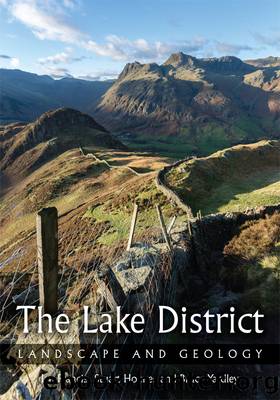Lake District by Francis Ian;Holmes Stuart;Yardley Bruce;

Author:Francis, Ian;Holmes, Stuart;Yardley, Bruce;
Language: eng
Format: epub
Publisher: The Crowood Press
A highly polished stone axe-head made from Langdale tuff, and recently found in Hertfordshire.
A production site for stone axes, on Glaramara, Seathwaite. Waste rock fragments and flakes litter the ground around the rock outcrop.
Some caution is needed, however, in identifying the source of stone axes from this time. Glacially transported Cumbrian tuff boulders are also found widely in eastern England, the Midlands and further south, and it may be the case that some stone axes found in these areas were fashioned on the spot, from erratic boulders.
A Langdale axe is a graceful and impressive object, but many of the hundreds of finished axes that have been found in the UK show little or no sign of use. For this reason, many archaeologists believe they must also have had great symbolic value, perhaps as ritual objects, or tokens of power, wealth and status. This is the role played by stone axes today amongst some of the remote tribes in New Guinea, for example.
Pollen analysis
As hayfever sufferers know only too well, plants shed microscopic grains of pollen dust into the air during the spring and summer. Most of these grains fall to the ground within a few hundred metres. Pollen from different plant species can be identified under the microscope, so examining a sample of pollen grains collected from a particular location will give an idea of which species were living in the vicinity. It is also possible to assess the approximate proportion of species present. For example, a sample taken from the soil in a heather moorland would show an overwhelming predominance of heather pollen, with smaller amounts of various grasses. In a typical Lake District mixed woodland, the proportions of pollen from oak, ash, alder, birch, and so on, would reflect the proportions of those tree species in the wood.
Such studies are invaluable in environmental reconstruction because, in the right conditions, pollen can be preserved for many thousands of years. Using carbon -14 dating of wood or charcoal fragments, it is possible to assign an approximate age to a layer of peat in a bog, or to an ancient layer of sediment in a lake bottom. Analysing the pollen from such a layer will therefore give a picture of the vegetation prevailing at the time. Furthermore, a series of samples from successively higher (that is to say, younger) layers in the sequence may be used to illustrate how the vegetation of the area has changed over time.
This combination of carbon dating and pollen analysis has enabled environmental scientists and archaeologists to draw important conclusions about the vegetation history of the Lake District over the last 6000 years.
Download
This site does not store any files on its server. We only index and link to content provided by other sites. Please contact the content providers to delete copyright contents if any and email us, we'll remove relevant links or contents immediately.
Man-made Catastrophes and Risk Information Concealment by Dmitry Chernov & Didier Sornette(5630)
The Revenge of Geography: What the Map Tells Us About Coming Conflicts and the Battle Against Fate by Kaplan Robert D(3944)
Zero Waste Home by Bea Johnson(3643)
In a Sunburned Country by Bill Bryson(3351)
Good by S. Walden(3338)
COSMOS by Carl Sagan(3335)
The Fate of Rome: Climate, Disease, and the End of an Empire (The Princeton History of the Ancient World) by Kyle Harper(2850)
Camino Island by John Grisham(2710)
A Wilder Time by William E. Glassley(2682)
Organic Mushroom Farming and Mycoremediation by Tradd Cotter(2557)
The Ogre by Doug Scott(2491)
Human Dynamics Research in Smart and Connected Communities by Shih-Lung Shaw & Daniel Sui(2427)
Energy Myths and Realities by Vaclav Smil(2374)
The Traveler's Gift by Andy Andrews(2294)
9781803241661-PYTHON FOR ARCGIS PRO by Unknown(2263)
Inside the Middle East by Avi Melamed(2228)
Birds of New Guinea by Pratt Thane K.; Beehler Bruce M.; Anderton John C(2169)
A History of Warfare by John Keegan(2088)
Ultimate Navigation Manual by Lyle Brotherton(2036)
